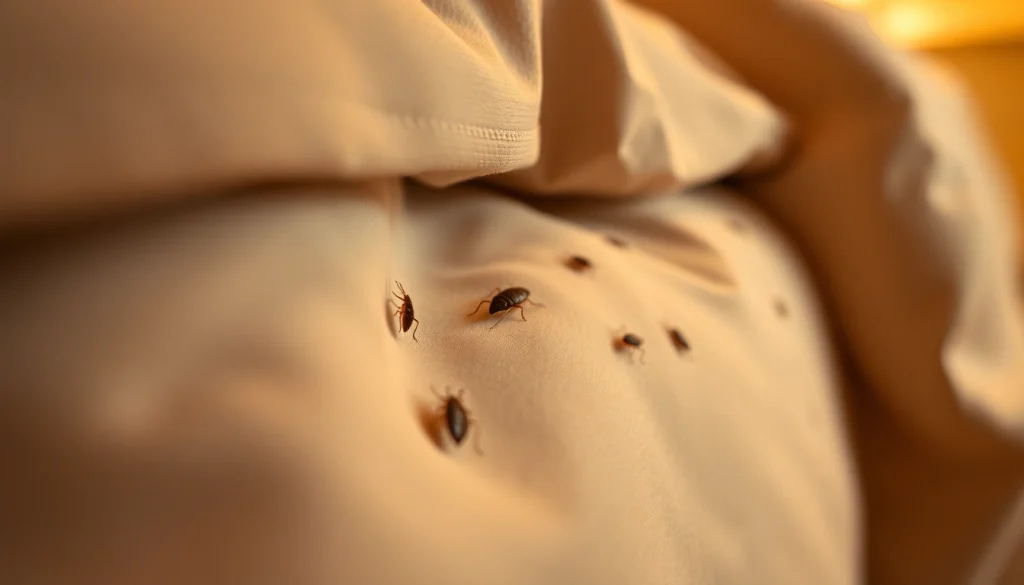Understanding Bed Bugs
What Are Bed Bugs?
Bed bugs, scientifically known as Cimex lectularius, are small, flat, reddish-brown insects that feed on the blood of humans and animals, primarily at night. Adult bed bugs are about the size of an apple seed, measuring approximately 4-5 mm in length. They are notorious for their ability to hide in small crevices, including mattress seams, furniture joints, and even electrical outlets, making them particularly challenging to detect and eradicate.
Common Signs of Infestation
Identifying a bed bug infestation early can prevent a more significant problem down the line. Look for:
- Bite Marks: Small, itchy welts on your skin that may appear in clusters.
- Rusty Spots: Stains on bed linens or mattresses from bed bug excrement or crushed bugs.
- Eggs and Sheddings: Tiny white eggs (about 1 mm) or shells left behind after bed bugs molt.
- Musty Odor: A sweet, unpleasant smell that increases with infestation severity.
Health Risks Associated with Bed Bugs
While bed bugs are not known to transmit diseases, their bites can lead to a range of health issues, including:
- Allergic Reactions: Some individuals may experience severe allergic responses to bed bug bites.
- Secondary Infections: Scratching bites can lead to skin infections, requiring medical treatment.
- Mental Health Issues: Anxiety, insomnia, and other sleep-related disorders as a result of worry about ongoing infestations.
Effective Bed Bug Control Methods
Integrated Pest Management Techniques
Integrated Pest Management (IPM) is a comprehensive approach that emphasizes prevention, monitoring, and control of bed bugs using a combination of methods. This holistic strategy often includes:
- Inspection: Thoroughly checking areas like mattresses, box springs, and furniture for evidence of bed bugs.
- Monitoring: Installation of bed bug interceptors and monitoring traps to assess pest activity.
- Control Measures: Utilizing both chemical and non-chemical treatments, such as heat or cold treatments, to eliminate bed bugs.
Regular monitoring and proactive measures can greatly reduce the chances of infestation.
DIY Bed Bug Control Strategies
Not every bed bug problem requires professional intervention. Here are some effective DIY control methods:
- Heat Treatment: Wash bedding and clothing in hot water (at least 120°F) and dry on high heat for 30 minutes to kill both bugs and eggs.
- Vacuuming: Regular vacuuming of suspected areas can help disrupt and capture bed bugs. Always dispose of the vacuum bag immediately.
- Decluttering: Reducing clutter minimizes hiding spots for bed bugs, making detection and control easier.
For more detailed guidance, refer to the bed bug control resources available online.
When to Call Professionals
In many cases, DIY efforts may not be enough, especially with severe infestations. It’s crucial to call a pest control professional when:
- The infestation is extensive and widespread.
- DIY methods have not yielded positive results after continued efforts.
- You’re unsure about the effectiveness of pesticides or application methods.
Professionals use advanced techniques and tools that can provide an effective long-term solution to bed bug problems.
Preventing Future Infestations
Best Practices for Homeowners
Preventative measures are essential for avoiding future infestations:
- Regular Inspections: Routinely inspect your home, especially after travel or purchasing used furniture.
- Encasements: Use mattress and pillow encasements that are bed bug-proof to protect against infestations.
- Reduce Clutter: Keeping living spaces tidy reduces potential habitats for bed bugs.
Safe Travel Tips to Avoid Bed Bugs
Traveling can often facilitate the spread of bed bugs. Here’s how to protect yourself:
- Check hotel rooms for signs of bed bugs, including scrutinizing matrasses and headboards.
- Keep luggage off the floor and bed by using luggage racks.
- Wash and dry all clothing immediately after returning home from trips.
Using Encapsulation and Monitor Systems
Encapsulating mattresses and box springs can effectively trap bed bugs and prevent them from spreading. Monitor systems, such as bed bug detectors and traps, are beneficial in early detection, allowing for timely intervention.
Products for Bed Bug Control
Choosing the Right Pesticides
Selecting the appropriate pesticide requires careful consideration of effectiveness and safety:
- Targeted Formulations: Look for pesticides that specify bed bugs on the label, ensuring they are designed for effective control.
- Environmental Impact: Consider the environmental effects of pesticide use, opting for those with a lower ecological footprint.
Effectiveness of Heat Treatment
Heat treatment involves raising the temperature of infested areas to a level that is lethal to bed bugs (around 120°F to 135°F). This method is particularly effective but should be applied by professionals to ensure thoroughness and safety.
Natural and Non-Chemical Solutions
For those seeking alternatives to chemical treatments, various non-chemical solutions are available:
- Silica Gel: This product can desiccate bed bugs when they come into contact with it.
- Essential Oils: Certain essential oils, such as tea tree or lavender, have been shown to repel bed bugs, although their effectiveness varies.
FAQs About Bed Bug Control
How Fast Can I Get Rid of Bed Bugs?
The speed of eradicating bed bugs largely depends on the severity of the infestation. A combination of methods, including chemical treatments and thorough cleaning, can lead to quick results, but generally, it may take several weeks for complete elimination.
Are DIY Methods Effective?
DIY methods can be effective, particularly for smaller, early-stage infestations. However, they often require diligence, persistence, and proper techniques to be completely successful. Comprehensive control usually involves professional assistance.
Can I Sleep in My Bed After Treatment?
After professional treatment, it’s crucial to follow the advice provided by your pest control expert. Generally, you may be advised to wait a few hours to a couple of days before sleeping in treated areas to ensure that the treatment is fully effective.
You may also like
-
Key Considerations When Choosing an Eprescription App for Your Practice
-
Understanding Eprescribing Compliance: Essential Guidelines for Healthcare Providers
-
Maximizing Efficiency with Eprescribing Software for Healthcare Providers
-
Top Picks for Effective Fat Burning Supplements for Women and Men
-
Top Choices for Best Fat Burner for Women/Men: Your Guide to Effective Weight Loss
